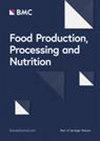苦瓜味无酒精小麦啤酒(NAWB)通过调节碳水化合物代谢酶,上调高脂饮食/链脲佐菌素(HFD/STZ)诱导的糖尿病大鼠胰岛素和GLUT-2 mRNA的表达,具有抗糖尿病作用
IF 5.7
3区 农林科学
Q2 FOOD SCIENCE & TECHNOLOGY
引用次数: 0
摘要
摘要:为了改善对2型糖尿病(T2D)的控制,本研究调查了用苦瓜叶调味的无酒精啤酒的潜在益处,苦瓜叶是一种已被证实具有降血糖特性的植物。采用高脂/链脲佐菌素(HFD/STZ)模型诱导Wistar大鼠糖尿病。将大鼠分为8组(n = 5): HP (STZ + 100% Hops);BG (STZ + 100%苦瓜);75:25BG (STZ + 75% Hops;bg) 25%;50:50BG (STZ + 50% hops50%苦瓜);25:75BG (STZ + 25% hops75%苦瓜);阿卡波糖(STZ +阿卡波糖)DC (stz -糖尿病对照组);NC(正常对照组)。治疗14天后,两组间的差异有显著性(p <0.05)降低血糖、血清葡萄糖、α-淀粉酶活性、α-葡萄糖苷酶活性和脂肪酶活性。随着苦瓜包埋率的增加,GLUT-2和胰岛素基因的表达上调。啤酒花含量最低(25:75BG)的啤酒,其血糖指数(GI)最低。该研究表明,苦瓜味的无酒精啤酒通过多种途径降低血糖,可能是治疗2型糖尿病的一种有用的饮食干预。图形抽象本文章由计算机程序翻译,如有差异,请以英文原文为准。
Bitter gourd flavored Non-Alcoholic Wheat Beer (NAWB) exhibited antidiabetic properties by modulating carbohydrate metabolizing enzymes and upregulates insulin and GLUT-2 mRNA expressions in High Fat Diet/Streptozotocin (HFD/STZ) induced diabetic rats
Abstract To improve the control of Type 2 diabetes (T2D), this study investigated the potential benefits of an alcohol-free beer flavored with bitter gourd leaves, a plant with proven hypoglycemic properties. The high fat/streptozotocin (HFD/STZ) model was used to induce diabetes in Wistar rats as test subjects. The rats were divided into eight groups ( n = 5) as follows: HP (STZ + 100% Hops); BG (STZ + 100% Bitter Gourd); 75:25BG (STZ + 75% Hops; 25%BG); 50:50BG (STZ + 50%Hops50%Bitter Gourd); 25:75BG (STZ + 25%Hops75%Bitter Gourd); Acarbose (STZ + Acarbose); DC (STZ-diabetic control group); NC (Normal Control group). Following a 14-day treatment, there was a significant ( p < 0.05) reduction in blood sugar, serum glucose, α-amylase activity, α-glucosidase activity, and lipase activity. As the percentage of bitter gourd inclusion increased, the expression of GLUT-2 and insulin genes was upregulated. The beer sample with the lowest percentage inclusion of Hops (25:75BG) had the lowest glycemic index (GI). The study suggested that bitter gourd-flavored alcohol-free beer reduces blood glucose through muptiple pathways and could be a useful dietary intervention in the management of type 2 diabetes. Graphical Abstract
求助全文
通过发布文献求助,成功后即可免费获取论文全文。
去求助
来源期刊

Food Production, Processing and Nutrition
Medicine-Public Health, Environmental and Occupational Health
CiteScore
6.90
自引率
4.30%
发文量
28
审稿时长
12 weeks
 求助内容:
求助内容: 应助结果提醒方式:
应助结果提醒方式:


